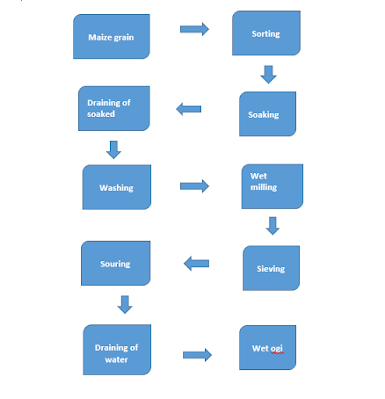PROPERLY FERMENT AND PREPARE YOUR OGI/KOKO/AKAMU/PAP! IT CAN SAVE YOUR LIFE!
Feed the Future Innovation Lab for Food Security Policy: Nigeria Agricultural Policy Project September 2018
Oluwatoyin Ademola Saweda Onipede
Liverpool-Tasie Adewale Obadina
Felicia Wu & Nikita Saha Turna
What are Mycotoxins?
Mycotoxins are dangerous substances (toxins) produced by some particular types of fungi. Mycotoxin contamination of staple crops is a severe health concern and maize is one of the crops often affected by mycotoxin contamination in Nigeria.
There are several of these mycotoxins but two key mycotoxins are aflatoxins and fumonisins. They are produced by fungi of the group Aspergillus and Fusarium respectively.
Why are mycotoxins dangerous?
Mycotoxins are dangerous because some have toxic and carcinogenic effects on humans and animals that consume them. This means they can make you very sick and can cause diseases such as liver cancer. They can also cause stunted growth in children and adverse immune system defects. The effect of mycotoxins on human health is not always immediate. However, continuous ingestion of even small amounts of these toxins in food over time can make consumers sick.
Most Nigerians are not aware of these dangerous toxins in foods. People consume food as long as it looks attractive and clean. But not all these foods are safe. Not all infected maize looks moldy or bad.
How can mycotoxins be reduced in foods?
One approach to reducing mycotoxins in foods is through processing as is done in making products such as Ogi/Koko/Akamu/Pap. Ogi is affordable and consumed widely across Nigeria as breakfast food. It serves as a weaning food for infants, a convenient meal for young children, the sick and the old. Ogi is often processed for sale at the market or it can be processed at home.
Source: allnigerianrecipes.com
When done properly, processing can significantly reduce some of these toxins. However, the right processing practices are not always used by processors. The most important stages are often neglected or incomplete. Thus this pamphlet provides some basic information about best processing practices to ensure that your household is consuming a safe and healthy product.
Fermentation is an important step during maize processing. It usually involves two stages. The first stage is soaking maize grain in water for two days before wet milling and the second stage is souring. Souring means adding clean water to the wet milled ogi after it has been sieved to allow the ogi to have a sharp smell and taste (like lemon). Souring is also done for two days.
However the second stage is usually neglected by most processors while soaking for two days in the first stage is usually incomplete. The fermentation stage reduces mycotoxins in maize grain but the two stages of fermentation need to be done properly to achieve this result
Source: allnigerianrecipes.com
Processors and consumers need to be aware that though fermentation reduces mycotoxins, the final levels of mycotoxin in the product (ogi) will also depend on the initial level of mycotoxin in the raw material (maize) and the extent to which they follow good practices. Thus, it is important to buy good maize, store it properly and process it properly to guarantee a safe final product. Below are the steps to take to have a safe product:
1. Avoid purchasing moldy, broken and damaged maize grains- These have higher levels of mycotoxin exposure.
2. Keep maize grain away from moisture if not processed immediately. Make sure you store the maize in a dry place.
3. Sort maize grain carefully to remove any form of dirt.
4. Soak maize grain in water for the appropriate number of days. Usually two days.
5. Souring should be done for at least two days before sales or consumption.
6. For home use, the surface water on the ogi after souring should be removed every two days and replaced with clean water.
Below is a chart showing the different stages in ogi production;









Comments
Post a Comment